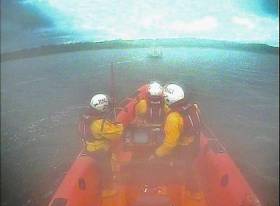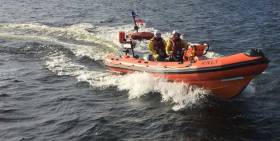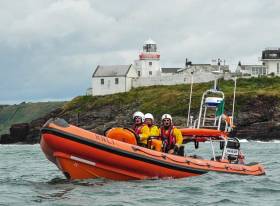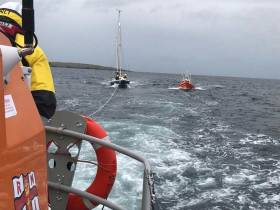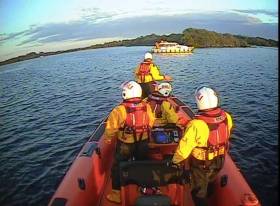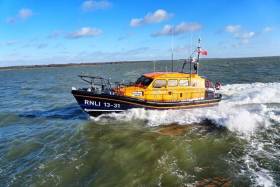Displaying items by tag: Lifeboat
Youghal RNLI Assist Grounded Yacht
Youghal RNLI was tasked at 11.58 am on Friday 8 November by the Coast Guard to help assist them in recovering a yacht that had gone aground at Harvey’s Dock after becoming loose from its moorings.
In calm and clear conditions, the volunteer crew of, Helm Liam Keogh, Alan Revins, Ivan Bryan and Noel Joyce launched the Atlantic 85, Inshore Lifeboat on the rising tide and reached the yacht within 2 minutes.
A tow line was established and as the yacht moved back onto the water it became submerged. The Lifeboat continued to tow the vessel until they reached a place where it could be secured. With the help of Youghal Coast Guard Unit the yacht was tied to the end of the pier. The lifeboat was then stood down and asked by the Coast Guard to return at low tide.
"The lifeboat was then stood down and asked by the Coast Guard to return at low tide"
Launching again at 9 pm in dark and cold conditions, the inshore lifeboat under the Helm of John Griffin Jr, Joe O’Connor, James Hanna and Thomas Brooks returned to the yacht to assist the Coast Guard in the water. Two volunteer crew members entered the water where they secured numerous buoys and barrels to the yacht to help to re-float it on the rising tide.
Mark Nolan, Youghal RNLI Deputy Launching Authority said: ‘The success of the call outs today was due to the teamwork with our colleagues in the Youghal Coast Guard unit. Thankfully the yacht is now secure and drying out to relief of the owner. I would also like to thank all the volunteer shore and boat crew who assisted today’.
Lough Derg RNLI Assist 30ft Yacht Aground near Pike Island
At 3.40 pm yesterday Lough Derg RNLI was requested by Valentia Coast Guard to go to the assistance of two people whose vessel had run aground near Pike Island, north of Kilgarvan Quay on the Tipperary shore.
Volunteer crew with helm, Owen Cavanagh, Eleanor Hooker and Keith Brennan launched the inshore lifeboat Jean Spier in mild weather conditions with Force 3 winds.
Upon arriving on the scene a crew member transferred to the casualty vessel and established that both people on board were wearing their lifejackets and were in no immediate danger. However, the boat had suffered damage to the rudder and the steering was not working.
"The lifeboat crew set up an astern tow and took the boat from the rocks and into safe waters"
The lifeboat crew set up an astern tow and took the boat from the rocks and into safe waters. They then proceeded to Kilgarvan Quay where an alongside tow was used to safely bring the casualty vessel into the harbour and it was tied alongside at 4.50 pm.
Owen Cavanagh, volunteer helm at Lough Derg RNLI said: ‘Before heading out on the lake, we advise people to familiarize themselves with the correct charts and pay close attention to the markers. Ensure everyone on board knows how to call for help. If you find yourself in trouble, call 999 or 112 and ask for the coastguard
Lough Derg RNLI lifeboat was requested by Valentia Coast Guard to assist a family of three, two adults and a child, on a 21ft cruiser suffering engine failure near the County Clare shore today.
Weather conditions were calm with Force 2 winds and good visibility.
The lifeboat, with helm Dom Sharkey and crew Michael O'Sullivan and Tom Hayes on board, reached the casualty vessel at 12.10 pm. The skipper of the vessel had dropped anchor to prevent his boat drifting onto the rocky shore. Once the RNLI volunteers established that the people on board were safe and well and that the vessel had not suffered damage, they set up for a tow and took in the anchor.
At 12.30 pm the lifeboat had the cruiser, with her passengers and an RNLI crew member on board, under tow to Mountshannon Harbour.
After tying the cruiser safely alongside at Mountshannon Harbour, the lifeboat returned to Station and was ready for service again at 2.30 pm.
Dom Sharkey, volunteer helm at Lough Derg RNLI said: ‘We advise people to ensure that their vessels are regularly serviced, and, in the event of difficulties, to always carry a means of communication.'
Crosshaven RNLI Rescue Capsized Sailors in Cork Harbour
Crosshaven RNLI rescued two sailors this evening after their catamaran dinghy capsized East of the Spit Lighthouse within Cork Harbour. The Crew of Crosshaven RNLI received pagers at 5.35 pm and launched with James Fegan in command and Caoimhe Foster, Alan Venner and Derek Moynan also on board and made best speed to the area. On scene, the cold and wet crew were transferred from the hull of the vessel to the lifeboat and a medical assessment was made. The Crosshaven Coast Guard RIB also arrived on scene and it was decided they would get the crew ashore as quickly as possible and back to their warm car at White Point. The volunteer RNLI crew righted the upturned vessel and towed it to the slip at White Point for retrieval.
Conditions in the harbour were relatively calm with a NW Force 3-4 wind.
Speaking after the service, JP. English, Deputy launching authority, commended the RNLI crew for their speed of response and the casualty crew for staying with their vessel whilst awaiting rescue. He reminded water users “to always carry a means of calling for help, and to Respect the Water at all times.”
Shore crew on this service were Jonathan Birmingham, Paddy Quinlan, Susanne Deane, JP English, Claire Morgan and Vincent Fleming.
Aran Islands RNLI came to the aid of two people yesterday evening (Bank Holiday Monday 5 August) who required medical attention off the islands.
The all-weather Severn class lifeboat David Kirkaldy was requested to launch at 8 pm by the Irish Coast Guard.
Two patients on Inis Mór, the largest of the three Aran Islands were in need of further medical attention.
Weather conditions at the time of the call out were moderate with 1.5m sea swell and a force 6 south-westerly wind.
The all-weather lifeboat launched under Coxswain Mairtín O'Flaithearta and a full crew. With the patients safely aboard the lifeboat and under the supervision of the volunteer crew members, the lifeboat headed straight for Rossaveal Harbour.
Speaking after the call out, Aran Islands RNLI Coxswain Mairtín O'Flaithearta said: ‘It was a wet and windy night, but the volunteer crew are always ready and willing to help anyone, no matter the weather. We would like to wish the casualties a speedy recovery’.
Clifden RNLI Lifeboat Assist Three Yacht Crew Near Inishbofin
Three crew on board a yacht which experienced difficulty off Inishbofin, North Connemara, were rescued by the RNLI Clifden crew on Saturday evening writes Lorna Siggins
The yacht had been on passage to Inishbofin when its dinghy broke loose, according to Clifden RNLI.
One of the yacht’s three crew jumped aboard it but found that that the dinghy’s engine would not start, and was then stranded as the yacht had no motor power.
Clifden’s Atlantic 85 lifeboat was launched first by shore crewman John Heffernan, who then also launched the boarding boat to the Mersey Class all-weather lifeboat Fisherman’s Friend, according to Clifden RNLI press officer Catherine Pryce.
“On the way, the lifeboats received an update that another yacht had managed to get to the crew man’s aid and passed the dinghy back to the yacht,” she said.
“ However, when the Atlantic 85 arrived on the scene, it broke free from the assisting yacht once again,” Ms Pryce said.
The lifeboat retrieved the dinghy, but weather conditions were force 5 to 6 and deteriorating and the yacht’s VHF was not functioning. The yacht crew agreed to return to Inishbofin, under tow.
Clifden RNLI’s all-weather coxswain James Mullen was assisted by crew David O Reilly, Ashling Sweeney, Thomas Davis, Ian Shanahan and Michael Carey. The Atlantic 85 was helmed by Joe Acton, with Kenneth Flaherty and Chris Nee also on crew.
The incident was the second in a busy week for Clifden RNLI, which took delivery of its new Shannon-class all-weather lifeboat last Wednesday.
A man whose leg got trapped on the Connemara shoreline during a rising tide was brought to safety in a multi-agency rescue involving RNLI Clifden, the Irish Coast Guard’s Cleggan unit and Sligo helicopter last Thursday evening (Aug 1).
Clifden RNLI Rescue Man Trapped in Shoreline Fall
A man whose leg got trapped on the Connemara shoreline during a rising tide was brought to safety in a multi-agency rescue on Thursday evening writes Lorna Siggins
The incident occurred when a couple were out walking at Slackport on Slyne Head, close to Ballyconneely, according to the RNLI Clifden lifeboat station.
The man fell on the shoreline, trapping his leg badly in some rocks and was unable to free himself. RNLI Clifden station press officer Catherine Pryce says the location was close to the high watermark in a rising spring tide.
The RNLI Clifden lifeboat and Cleggan Coast Guard volunteers, along with the Irish Coast Guard Rescue 118 helicopter from Sligo responded after the couple raised the alarm.
Clifden’s Atlantic 85 inshore lifeboat was launched with Joe Acton at the helm, along with the station’s Mersey class all-weather lifeboat under the command of coxswain James Mullen.
“ The Atlantic 85 was first on the scene and crewman Alan Pryce went ashore to assess the situation and administer first aid. Alan was quickly joined by two more crew members from Clifden’s all-weather boat,” Ms Pryce said.
The man’s injuries were assessed, and he was winched up to safety by the Sligo helicopter crew.
Clifden’s RNLI lifeboat station took delivery of a new all-weather Shannon class lifeboat earlier this week, which will increase the station’s range and capability.
‘This was an urgent and very serious call out and the crew located and assisted the casualty very quickly,” Clifden RNLI operations manager John Brittain said.
“ It has been a very busy week for our station with the arrival of our new Shannon class lifeboat, and the crew once again demonstrated that they are always there to respond when needed, working closely and effectively with our Coast Guard colleagues," Mr Brittain added.
Aran Islands RNLI came to the aid of a young boy yesterday evening who required medical evacuation.
The volunteer crew were requested to launch their lifeboat at 9.16pm by the Irish Coast Guard following a report that a young boy on Inis Mór needed medical attention.
The all-weather Severn class lifeboat David Kirkaldy immediately launched under Coxswain John O'Donnell and a full crew.
Weather conditions at the time of launching were good with calm seas.
On scene the crew safely transferred the boy aboard the lifeboat and under the supervision of the volunteer crew members, the lifeboat headed straight for Rossaveal Harbour.
Speaking after the call out, Aran Islands RNLI Coxswain John O'Donnell said: ‘Time can make all the difference in any medical evacuation, our volunteer crew members train regularly to maintain their quick response time. We would like to wish the casualty a speedy recovery.’
Valentia Coastguard Requests RNLI to Launch at Lough Derg
At 9 pm on Sunday, Valentia Coast Guard requested Lough Derg RNLI to go to the assistance of six people, four adults and two young children, on a 35ft cruiser aground inside the Mountaineer buoy at Ryan’s Point, on the eastern shore of Lough Derg.
At 9.17pm the lifeboat launched with helm Eleanor Hooker, Dom Sharkey, Joe O’Donoghue and Chris Parker on board. The wind was easterly, Force 2 with good visibility.
Once the lifeboat rounded the Mountaineer Buoy, a lifeboat crew took soundings from the bow, whilst another checked depths on the navigation charts.
When the lifeboat came alongside, the crew established that all people on board the casualty vessel were safe and unharmed and wearing their lifejackets. Two RNLI volunteers were transferred to the cruiser and, once satisfied that the vessel was not holed, set up for a tow.
The lifeboat took the vessel off the rocks and out into safe water, where an RNLI volunteer ensured that the drives, steering and rudder were in good working order. Once the cruiser was safely underway and making way to their next harbour, the lifeboat returned to Station.
Peter Kennedy, Deputy Launching Authority at Lough Derg RNLI advises boat users ‘to plan your passage and pay close attention to the navigational buoys that mark safe water on the lake’.
The lifeboat was ready for service again at 10.12pm
The community of Clogherhead is set to welcome the latest RNLI lifeboat to be based in Ireland, to their town on Sunday 2 June. This Shannon class lifeboat is unique in the RNLI’s fleet as it has been funded by an Irish legacy, named after an Irish lifeboat volunteer, designed by an Irish engineer and is the first class to be called after an Irish river. The Michael O’Brien Shannon class lifeboat is due to arrive in Clogherhead at exactly 13.31 which is also the operation number of the lifeboat.
Its arrival marks the start of a new chapter in the story of search and rescue in the north-east. The Shannon lifeboat is the latest in a long line of search and rescue boats provided by the RNLI to Clogherhead over the past 120 years. This lifeboat and its launching equipment represents a multi-million euro investment at the station and signals a major change in the level of service provided by the RNLI on the east coast as it moves the station from a 15-knot lifeboat to a 25-knot one, cutting vital minutes off the time it takes for the lifeboat crew to reach a casualty.
A significant proportion of the funding for the Clogherhead lifeboat has been provided through a generous legacy by a Wexford farmer, Mr. Henry Tomkins, who was a lifelong supporter of the RNLI. Henry stipulated that a lifeboat be named for his long-time friend, the former Arklow RNLI Coxswain, Mr. Michael O’Brien. The Shannon was designed by Derry man Peter Eyre who as child was rescued by Lough Swilly RNLI in Donegal.
The arrival of the station’s new Shannon lifeboat will take place in front of the beach beside the lifeboat station in full view of the public. It will be the first time in Ireland that the RNLI will use a SLARS (Shannon Launch and Recovery System) to launch and recover a lifeboat in Ireland. The SLARS acts as a mobile slipway for the lifeboat, which can be driven directly onto the beach for recovery. It has a unique turntable cradle, which can rotate the lifeboat 180º, ready to be launched again within 10 minutes.
Clogherhead RNLI Coxswain Tomás Whelahan said, ‘We want the people of Clogherhead and the surrounding areas to come to welcome the new lifeboat home. The station has been preparing for this day for a long time and there is huge excitement for it. The past few weeks and months have been spent in preparation and training by all the crew and shore crew, to receive this incredible piece of kit from the RNLI. It is the most technologically advanced lifeboat in the fleet, and it will proudly serve the east coast for many years to come.’
‘We are incredibly honoured to receive it and we are grateful to our donor Henry Tomkins and to the local communities, who by their generosity, have made this day possible. We hope to bring many loved ones safely home in this new lifeboat.’



























